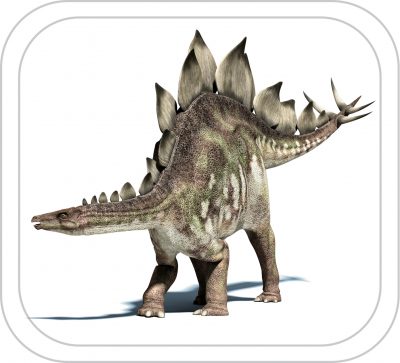Stegosaurus
Name: Stegosaurus
Pronounced: STEG-oh-SORE-us
Meaning: ‘Roof lizard’
Period: Late Jurassic (156 – 144 million years ago)
Group: Stegosaurs (covered lizards)
Size: It was between 8m – 9m long and 2.75m tall at the hips. It weighed around 3100kg.
Diet: Herbivore
Characteristics: The Stegosaurus walked on four legs but there has been much debate about this. It had seventeen bony plates embedded into the skin of its back and tail in two rows, alternating in alignment. These bony plates were not attached to the skeleton, which is why in most fossil finds the plates are detached from the body. The largest of these triangular plates was about 76 cm tall and just as wide. When Marsh described the first fossil of a Stegosaurus, he concluded the plates lay flat on its back. After finding a specimen preserved in mud, he realised the plates stood upright on either side of the spine. Palaeontologists do not agree what the plates were used for. They may have acted as a warning to predators, or helped them to identify each other. Another suggestion is that the plates were used to control the temperature of their body, as there were tiny grooves on the surface of the plates, which possibly contained veins. The amount of blood passing through these veins would determine the dinosaur’s temperature. The Stegosaurus also had spikes at the end of its flexible tail. Compared with the rest of its body, the Stegosaurus had a small head and its brain was around the size of a golf ball. They had flat and blade-like teeth and probably ate low-growing vegetation.
Named by: Othniel Charles Marsh in 1877
Discovery:
The first Stegosaurus fossil was found in Morrison, Colorado in 1876 by M. P. Felch. Others have been found since in Utah, and Wyoming, North America.

